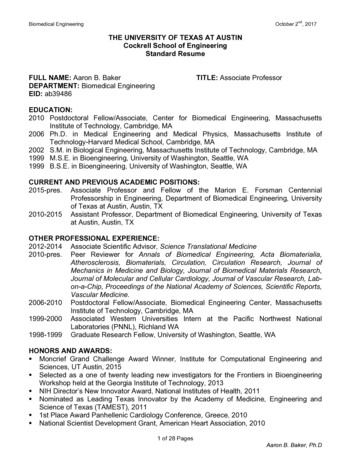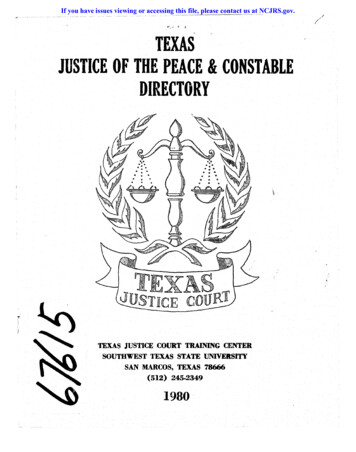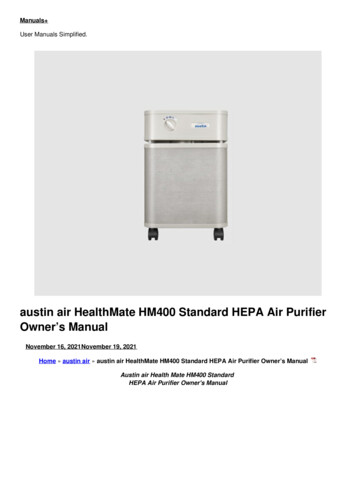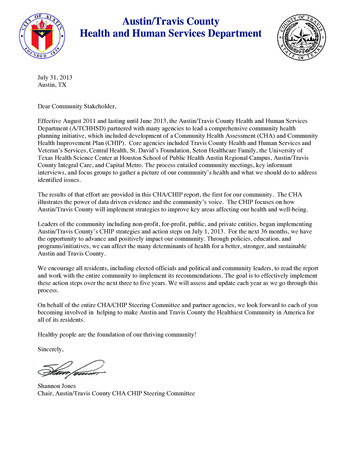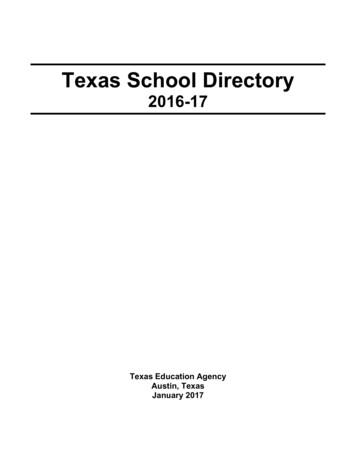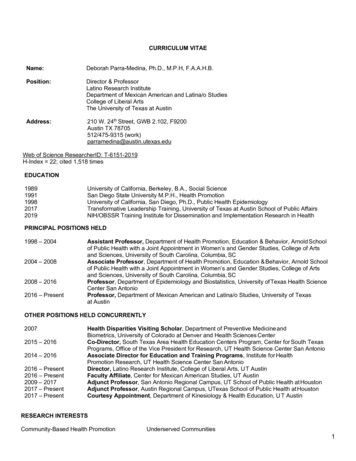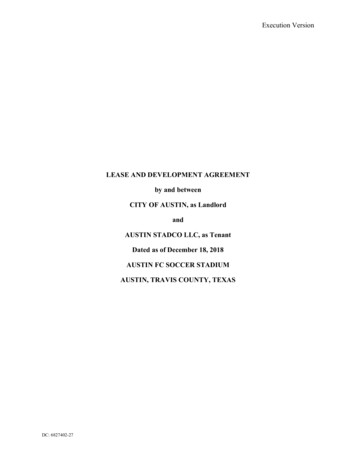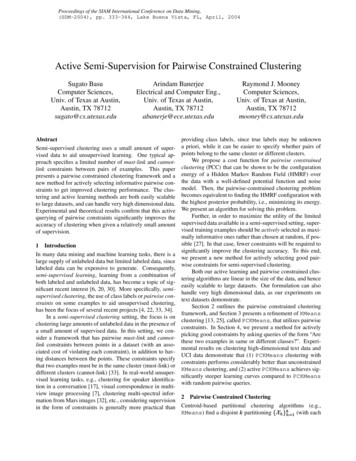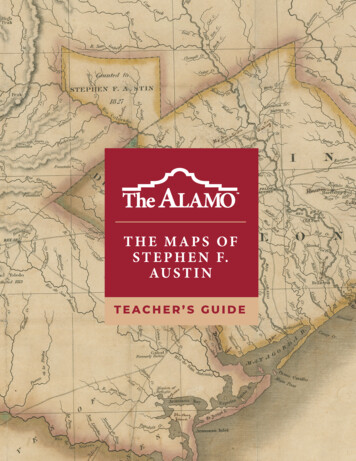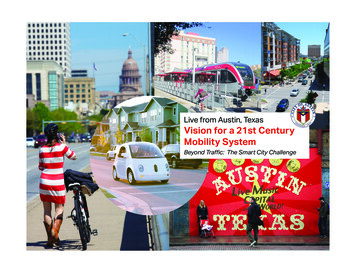
Transcription
Live from Austin, TexasVision for a 21st CenturyMobility SystemBeyond Traffic: The Smart City Challenge
Beyond Traffic: The Smart City ChallengeCONTENTSb1. Austin’s smart city vision—and how it will be achieved.1Why Austin?. 1Our Challenges . 2Our Future . 3Austin’s Mobility Innovation Center . 4Austin’s 21st Century Smart City Mobility Initiatives. 6Initiative #1: Automated and Connected Vehicles. 6Initiative #2: Electric Fleets. 8Initiative #3: Sensor Systems. 8Initiative #4: Travel Access Hubs . 9Initiative #5: Packaged Mobility Service .10Moving Beyond Traffic.102. Population Characteristics.113. Smart City Characteristics .114. Annotated Preliminary Site Map .135. Smart City Vision Elements .135.1 Urban Automation .135.2 Connected Vehicles .145.3 Intelligent Sensor-Based Infrastructure .165.4 Urban Analytics.165.5 User-Focused Mobility Services and Choices .175.6 Urban Delivery and Logistics .175.7 Strategic Business Models and Partnering .175.8 Smart Grid, Roadway Electrification, and Electric Vehicles .185.9 Connected, Involved Citizens.18February 20165.10 Architecture and Standards.185.11 Low-Cost, Efficient, Secure, and Resilient ICT.195.12 Smart Land Use. 206. Risk Management.217. Team Narrative .218. Existing Transportation Infrastructure . 239. Define Existing Data Collection.2510. ITS and Connected Vehicle Standards.2611. Measurable Goals and Objectives .2712. Evidence of Capacity to Succeed . 2913. Opportunities to Leverage Federal Funds. 30
1Beyond Traffic: The Smart City Challenge1. AUSTIN’S SMART CITY VISION—AND HOW IT WILL BE ACHIEVED“Igniting Austin’s spirit of innovation to accelerate mobility that creates real opportunity for all.”As the USDOT Smart City, Austin, Texas, will harness the power of technology and data to help people shift their travel behaviors in ways that work for them. Faster, better, cheaper. advance big societal goals for climate action and sustainability. Cut vehicle emissions. keep people far safer on our streets. Prevent fatal and serious injury crashes. . power up economic vitality. Create services, products, companies; give people a hand up.It will take a Smart City to seize the moment and figure it all out. Meet Austin, Texas!WHY AUSTIN?Austin is America’s “IT” City. We are the capitalof the state of Texas. We’re home to both theUniversity of Texas at Austin (UT Austin)—oneof the nation’s premier research universities,and a USDOT Tier 1 University TransportationCenter for Data-Supported Transportation Operations and Research – and within close reach of thenationally renowned Texas A&M TransportationInstitute (TTI). We are internationally known asa “creative class” magnet where the mantrais “Keep Austin Weird.” We are “the live musiccapital of the world” home to SXSW interactive,film, and music festivals. We are a progressive,and innovative community that embraces climatewith early adoption of all things green. Due toour younger demographics and an innovative andvibrant high-tech community, there is a demand formore choices for transportation that incorporatetechnology and keep people connected. Austin is agrowing city that still has a connected, small towncommunity feel that is part of our allure and charm.Austin is already recognized by industry as theplace to demonstrate smart transportation technology. Austin is the first mid-size test city for theGoogle Car, a first city for Google Fiber, and General Motors recently expressed interest in testing itsautomated vehicles in Austin in partnership withridesharing company Lyft. Austin was chosen byDaimler as its pilot U.S. city for Car2Go, which hassince expanded nationally. The business climateis seen as friendly toward autonomous vehiclesand smart technologies more generally. The warmtemperatures allow year-round testing. And, ofcourse, Austin is a major U.S. hub for the high-techindustry, known as an Research and Developmentcenter. In 2015, Austin was named the “#1 city fortech job growth” by Forbes. In the last four years,we’ve seen a 73 percent job growth in the techindustry, resulting in more than 53,000 tech jobs.Austin’s potential was also recently recognizedby Rocky Mountain Institute (RMI) when it waschosen after a nationwide selection process tobe the lead partner for a new mobility transformation initiative. Austin is making robustinvestments in new transportation options– Bus Rapid Transit (BRT), rapid implementationof a bicycle network featuring new protectedfacilities, the first U.S. City for Daimler’s Car2Go,the B-Cycle Bike Share system, and more.Austin’s public transit agency has receivednational recognition for its innovation withmobile ticketing. Additionally, and importantly,Austin owns its electric utility, Austin Energy,which has been a leading innovator for climateprotection, clean power, electric vehicles, and asmart grid.Among mid-size cities, Austin’s need for smarttransportation solutions may be the greatest dueto its rapid growth and booming economy.Austin is the fastest-growing mid-size city in theU.S. (1.8 million regional population, a 2.8 percentgrowth rate), absorbing tens of thousands of newThe City of Austin, Texas1
Beyond Traffic: The Smart City Challenge2residents annually. A city in such constant fluxprovides a fertile environment for innovation aspeople adopt new travel options and behaviors.Austin is prepared to take advantage of this opportunity to hasten its transition to a Smart City.Many of the ideas in this proposal have resultedfrom discussions with the City’s partners for overa year. Additionally, Austin has several relevantplans in place that have been crafted within anextensive public process. These include plansfor smart growth (Imagine Austin Comprehensive Plan, 2012), climate action (Community Climate Plan, 2015), zero traffic fatalities (recentlyselected as a Vision Zero Network city), and more.Further, Austin is committed to tech incubationand was recently listed by Entrepreneur Magazineas the #1 city for startups.OUR CHALLENGESAustin is also on some “top” lists we are not soproud of, and from which our residents want toescape. Despite the incredible advantages weenjoy, we are too often stuck in traffic, frustrated,and demanding mobility solutions: Traffic: Austin routinely rates as one of themost congested cities in the country (withI-35 through Downtown among the very worstfreeway segments in the nation). In Texas A&MUniversity Transportation Institute’s (TTI) 2015Urban Mobility Scorecard, Austin commuterssuffered the third greatest delay – 52 hoursper year - for “large” urban areas in the U.S.If the growth trajectory continues, peak hourFebruary 2016Jolene2016 Challenges:Works in catering.Dreams of havingher own taco trailer.Can’t quite afford acar.2020 Smart City Future: Takes transit to agreat job in marketing autonomous vehicles.Uses an app to rideshare to culinary schoolat night. Happily car-free.delay is projected to more than double in thenext 20 years. Sprawl: Like many U.S. cities, Austin grew insprawling patterns in the latter half of the 20thcentury. In our outlying car-dependent areas,people lack good transportation options andoften have no access to transit. Safety: Transportation system safety has beena huge concern for the City as 2015 proved tobe a record year for traffic fatalities with 102deaths. The City is seeking ways to leveragesmart transportation technologies and data toaddress unsafe conditions and provide moreeducational opportunities before a seriousinjury or fatality occurs. Climate Change and Emissions: Austin’stransportation infrastructure has been negatively impacted by recent droughts - fl oods, andwildfires as documented in a recent City climate resiliency project funded by FHWA. As of2010, about 35 percent of annual greenhousegas emissions were from the transportationsector. The Austin region is currently in attainment due to an early action compact with theEPA, but is at the tipping point of falling intonon-attainment for air quality.Perhaps even more importantly, our communityfaces significant Economic Disparity. Werecognize that daily life is a struggle for manypeople – especially for our low-income residents,who are disproportionately female and peopleof color. Austin is a diverse “majority minority”city and the most economically segregated largemetro area in the US, according to a recentlyreleased study by the Martin Prosperity Institute.In Travis County, Hispanics (now about 35 percentof the population and growing) are 3.4 times morelikely than Whites to be living in poverty; AfricanAmericans are 2.8 times more likely.Jayla2016 Challenges:Needs a path out ofpoverty at 15. Tooyoung for a job ordriver’s license. Solovocalist in her churchchoir.2020 Smart City Future: Takes a “green”EV taxi home from her band’s late-night gigs.Rides an EV shuttle to college campus; doinginternship at a traffic-sensor tech start-up.
Beyond Traffic: The Smart City ChallengeThe MendezFamily2016 Challenges:Altogether, theycommute by car 150miles a week to work,school, and soccer;two car payments; behind on savings for thekids’ college.2020 Smart City Future: Shifted some tripsto transit; commute time is reliable, thanksto better traffic flow; avoided cars for teens,put the money toward college instead.Our fastest-growing population sector is childrenliving in poverty. According to the Brookings Institute, the Austin metro area ranks #2 in the nationfor percentage growth of poverty in the suburbsbetween 2000 and 2011. Our suburban poor aregenerally not well transit-connected, nor withinreasonable walking or biking distance of jobs; theyare painfully burdened by the costs of car ownership, which can drive them further into poverty.New transportation options, coupled with smarterland use decisions and housing policies, are needed to provide our disadvantaged communities the“Ladders of Opportunity” they need to overcomeincome and transportation inequality.Reversing these trends will not be easy. Theconventional solutions to Austin’s challenges areneither scalable nor sustainable. Even incrementalprogress will require a great many people to shifttheir assumptions and familiar ways of doingthings. We need to demonstrate, in tangibleways, how mobility can be more accessible, safer,cleaner, and more affordable for all citizens. Withthe funding behind the Smart City Challenge – andthe additional investment that we attract fromour partners – we believe that we will be in anexcellent position to drive this change.OUR FUTUREWe intend to move Beyond Traffic to achievea future of new transportation possibilities. Inthe Austin of tomorrow, our downtown remainsvibrant, but people no longer need to assumethey’ll drive their own car to get there. Instead,they think first of on-demand automated electricvehicles, transit, biking, shared and on-demandvehicles, and other options. Prime sites oncedevoted to parking garages have redeveloped asmixed-use projects with homes. On the major corridors of the city, automated and electric vehiclesand drones zip along; they interweave alongsidepersonal vehicles through intersections withminimal need to stop and wait for a traffic light.These corridors connect compact “Activity Centers”around Austin -- cool, interesting, “Austiny” placeswhere people are enjoying car-free or low-VMTlifestyles in walkable, mixed-use, transit-orientedareas. Thanks to thoughtful rezoning, new mixeduse redevelopments have sprung up around thecentral city. People of all races, incomes, andages live in them together – and enjoy choosingbetween many travel options to get to goodjobs, good schools, live music venues, and otheropportunities.The suburbs and exurbs feel different too. Onthe perimeter of the city, Travel Access Hubsbustle with activity. People drop off their personalvehicles, or exit trains and buses, and step intowaiting autonomous transit and shared electricvehicles where they relax or check email on theway. Suburban commuters drop off their kids atan on-site daycare, grab a coffee at the coffeebar, and hop into an electric, automated bus thatwill whisk them to their job. Large trucks drop offFlorenceand George2016 Challenges:Live in suburbanRound Rock; cardependent, love theirold GM; help out withthe grandkids in Austin.2020 Smart City Future: Use Metropia appon smart phone to navigate traffic; get pointsfor shifting travel off peak. Take grandkids onelectric bikes for in-town adventures.packages and goods, which will be transportedby small, agile automated vehicles. Low-incomeresidents have access to low-cost and convenientmobility options that provide them access to jobsin any part of the city. Not only is this new mobilitysystem faster and less expensive, but it is alsomuch safer, since the vehicles and infrastructurehave advanced communication and sensor technology. Private vehicles throughout the core arestill present, they just aren’t the predominantThe City of Austin, Texas3
Beyond Traffic: The Smart City Challenge4mode of travel and are only one of many choiceseach resident and visitor has to choose from.With investment in smart transportation, this isa viable and possible future. The critical questionis: “How do we get to this vision from where weare today?”The answer is: “Make Austin, Texas the innovation epicenter for introducing, testing, evaluating,refining, commercializing and scaling a 21st Century Mobility System.”But how? In collaboration with some ofthe world’s most innovative companies,cutting-edge universities, and world-renownedexperts, the City of Austin has identified fiveimmediate opportunities that will engage avariety of public and private partners to deliverenhanced mobility and economic opportunitiesfor Austinites of all income groups. Theseinitiatives are consistent with the ideals ofUSDOT’s Smart City Challenge and are theconcepts which will be refined – with an eyetowards implementation and ensuring anequitable distribution of benefits for all membersof our community.Before we describe these initiatives, however,it is important to first discuss a unique andcollaborative feature of Austin’s 21st CenturyMobility System—Austin’s Mobility Innovation Center (MIC). The MIC is the foundation ofour proposed Smart City network, consisting offour components, which will work synergisticallyto deploy our Smart City initiatives in a holisticand integrated fashion.February 2016AUSTIN’S MOBILITY INNOVATIONproposed two-way portal will allow data to flowCENTERin to and out from all partners, including bothauthoritative as well as crowdsourced data. OurThe Mobility Innovation Centerproposed Two-Way Open Data Portal will provide(MIC) will serve as a “Center ofExcellence” for incubating cut- a “one stop shop” to facilitate easy access to datastreams that are currently siloed among manyting-edge ideas and deploying anddisparate sources and governed by fragmentedoperating a 21st Century Mobilitylicensingterms. These include traffic and transSystem. The MIC is operational; a think tank;portation information systems; users’an economic generator; public-facing; and mostsmart phonesimportantly, multi-jurisdictional. It also servesas project management central,the vehicle for managing theCity’s Smart City effort.ElectricA. Two-Way OpenFleetsAutomatedData Portal& ConnectedAs described in SectionVehicles9, the City of AustinMobilityalready has an Open DataInnovation CenterPortal (data.austintexas.gov).(MIC)A 21st Century Mobility System, however,A. Two-Way Openwill generate an enormous amount ofData Portalnew and very valuable data from moB. Urban Analytics andPolicy Research Centerbility and other sectors.SensorC. Regional OperationsWhile the systems areSystemsManagement Centerone-way, the newD. Connected TravelerPackagedtransportation porInitiativeMobilitytal, operated by theServiceThe University ofTexas at AustinFigure 1: IntegrationCenter for TransTravelof MIC and Fiveportation Research,AccessInitiativeswill allow for accelerated open data sharing. TheHubs
Beyond Traffic: The Smart City Challenge(anonymous and/or opt-in); private data (such asthird party location, weather, or schedule data);and transit vehicle location systems. Existinginformation will be complemented with access tothe new and unique data elements within datastreams associated with our Smart City initiatives.The Portal will: Be multi-dimensional, serving data consumerssuch as city traffic managers who optimizetraffic flow and private application developerswishing to develop Multi-modal planning tools. Protect privacy and security of data throughmeasures such as anonymization, especiallyfor crowd-sourced consumer data from privatecompanies; and Broker agreements with private transit andsoftware companies to incorporate their dataand establish common, replicable accessibilityand licensing practices.B. Urban Analytics and Policy ResearchCenter – A multi-disciplinary team of professionals will engage in ongoing support to help us better understand and analyze the performance datawe collect, and model future impacts on traveldemand. The Urban Analytics and Policy Research(UAPR) Center will manage the deployment of ourplanned Smart City initiatives and other projectsand share lessons learned throughout the nation.As we enter a new era of unprecedented changein the established models for mobility, aligningsupportive public policy and regulations is essential. We will leverage established research anduniversity expertise in technology policy (e.g.,The University of Texas at Austin Centerfor Transportation Research, Texas A&M’sTransportation Policy Research Center, UTAustin’s Lyndon B. Johnson School of PublicAffairs, and Southwest Research Institute)and work with technology businesses to sharenewly created knowledge with decision-makers.The UAPR Center will provide resources such astechnical and analysis papers that will help policymakers understand and balance potential socialbenefits and risks in a dynamic, fast-changingmarket. This includes research to evaluate and ensure that these benefits are equitably distributedacross the city’s diverse socio-economic groups.UT Austin’s Tier 1 University TransportationCenter for Data-Supported TransportationOperations and Planning (D-STOP UTC) teamwill develop novel methods for working with thelarge-scale data coming into and out of the portal.They will develop applicant programming interfaces (API) and other tools to allow for ease of use bythird-party companies. This partnership with theUTC will ensure that the work is done at the stateof the art and that the Austin Smart City effortpushes the boundaries of what is possible.Performance management is also a vital component in our 21st Century Mobility System. Havingan advanced data team reviewing trends andanalyzing characteristics will help us to betterunderstand important variables like defininga new vehicle class to represent connected/automated vehicles, defining driver behavior parameters for the new Connected and AutonomousVehicles (C/AV) class with smaller headways, andconducting sensitivity analysis for different penetration levels of the C/AV class.Through collaborative partnerships with thebrightest public and private sector minds, theUAPR Center will build a foundation for a commercialization cluster dedicated to sustainable growthand “smart” mobility innovation.C. Regional OperationsManagement CenterA common challenge for cities around the countryis the fractured, isolated nature of transportationmanagement – freeways are managed separatelyfrom arterials, state centers are independent fromcity management centers, traffic operations aremanaged independently from transit needs, etc.As part of our effort, Austin will launch a newregional operations management center (ROMC),at first in a virtual setting until a brick and mortarfacility is established. The ROMC will be an operational arm of the Mobility Innovation Center, andthe forum for multi-jurisdictional governance andengagement described in Section 7. It will serveas a unified “command center” for both traffic andtransit operations, supervising everything fromincident management to transit route planningand optimization. Working with data madeavailable from the Two-Way Open DataPortal, ROMC personnel will optimize signalsystems, engage existing and future trafficmanagement tools, proactively communicate live travel conditions and alternativesto travelers, and begin mainstreaming V2Iapplications as they become available.Operationally, the ROMC will support existingThe City of Austin, Texas5
Beyond Traffic: The Smart City Challenge6functions but also provide an optimal transitionto the 21st Century Mobility System as the homefor the newly deployed initiatives.The ROMC will further function as a trainingground for new mobility professionals as theygraduate from local trade schools and universities – giving them first-hand experience inutilizing predictive, real-time, and historical datain pursuit of reliable and safe transportationthroughout Austin. Finally, the ROMC will serveas the maintenance hub for Austin’s 21st CenturyMobility System, monitoring the health of technology devices, working with technicians to manageup-time of services and systems, and generatingperformance statistics that are the life-blood ofensuring long-term sustainability of the program.D. Connected Traveler Initiative – Every userof Austin’s transportation network – residents,delivery services, visitors, etc. – will have accessto real-time and predictive information to maketravel decisions that work for them. The connectedtraveler also will be a source of information toenrich the reliability of information being disseminated. Innovative companies can use this samedata to develop new products and services thatfurther serve travelers. We will also assure thatresidents and visitors who might be technologychallenged have access to data via public systemssuch as on-street wayfinding tools, dynamic message signs, etc.This connected traveler initiative (CTI) will alsoserve as the interface for community engagementfor Austin’ 21st Century Mobility System. Citizenscan provide feedback and ideas to help influenceFebruary 2016initiatives. The public communications capabilitywill include program and project websites, feedback and input loops such as focus groups, andopportunities for the public to contribute to theenhancement of the effort through crowdsourcing. SpeakUpAustin.org (administered by theCity’s Communications and Public InformationOffice) and MobilityATX.com (administered by aprivate organization) are two local examples ofexisting online platforms we can build upon. Wewill expand the toolkit to add features integratedwith social media (such as Twitter and NextDoor,already used by the City). Promising ideas submitted by the public will directly reach transportationengineers and planners.AUSTIN’S 21st CENTURY SMART CITYMOBILITY INITIATIVESWith the MIC serving as the platform for management and innovation, we will launch a coordinatedprogram that leverages all of the technology, innovations, and forward-thinking of the leading universities, experts, and private sector companiesright here in Austin. Each initiative synergizes andoverlaps with the others, and is focused on moving Austin’s transportation mobility infrastructuresystematically towards our holistic vision. Underthe institutional, functional and operational guidance of the MIC, we can deploy these initiatives,manage them long term, and learn from them forfuture enhancements and sharing.Below are our five priority initiatives to be implemented during the Challenge grant period and whythey are “ready for success.”INITIATIVE #1: AUTOMATED ANDCONNECTED VEHICLESConsumer-Facing Deploymentof Connected and AutomatedMobility ServicesGoal: Implement automatedand connected vehicles in avariety of settings, helping solve a numberof mobility challenges and demonstratingtheir safe and efficient benefits to Austinites.With leading tech company partnerships and anenabling Federal, state and local regulatory environment already in place, Austin is in a unique position among US cities when it comes to deploymentof connected & automated vehicles (C/AV). Thisdeployment will be coordinated with the evolvingpublic transportation system, as well as bicyclingand walking, to create a comprehensive networkof mobility options within the region. Since automation without connectivity won’t help us realizethe level of safety and mobility benefit we seek,connectivity is a fundamental component of allautomated elements. Technology leaders Googleand Car2Go (Daimler) are already “on the ground”in Austin, and we will further partner with leadingprivate sector companies to deploy their technology in several different environments -- consideringAustin’s Five Smart City Initiatives1.2.3.4.5.Automated and Connected VehiclesElectric FleetsSensor SystemsTravel Access HubsPackaged Mobility Service
Beyond Traffic: The Smart City Challengededicated short-range communication (DSRC) andconnectivity requirements, specific needs of thepublic, and different business models to fit eachsituation. Airport Automated Shuttles/CirculatorsThrough a partnership with Capital Metropolitan Transit Authority (Capital Metro) and techpartners who specialize in electric-poweredautomated shuttles, and based on interestalready expressed by the industry through an“Accelerate Texas” request for interest (RFI)solicitation (conducted in 2015), the City ofAustin will deploy transit circulators and smartinfrastructure to Austin’s international airport,as an early testbed for future full automationof the Austin transit fleet. The first componentwill be a low-speed automated and connectedshuttle that moves passengers between themain terminal and a new mobility hub andstaging area to be located in conjunction with acell phone parking lot. This reduces the numberof vehicles entering the terminal road system(thereby reducing congestion and pedestriansafety hazards), and increases the visibility and“comfort level” for our customers with adoptingautomated vehicles. Because of the simplifiedurban street network located wholly on airportproperty, it will provide a valuable learningenvironment for future deployments in morecomplicated urban street networks and to otherareas like business parks and eventually in thefuture to full public transit routes includingon-demand paratransit and transit shuttles inour downtown. Downtown On-Demand AutomatedVehicle Service Electrified, automated,on-demand vehicle and shuttle services havethe potential to increase safety and reduce thecost of mobility. Smaller vehicles and mid-sizetransit shuttles can be used for first/last mileapplications to enhance transit use, whilelarger transit vehicles can themselves be instrumented to facilitate a shift to automation oftransit. These vehicles can be most effectivelydeployed by integrating them directly with “Ato B” commuting solutions that are alreadybeing planned in downtown Austin. Thesevehicles will also benefit from connectivityand sensor-based infrastructure described inSections 5.2 and 5.3. The City and its partnerswill closely examine access to the system tomake sure service is available to everyone, toimprove the lives of all Austinites, includingthose with low incomes, the elderly, and thedisabled. Specifically, this demonstration project will seek to bridge the jurisdictional gapfor urban residents outside the Capital Metroservice area that lack access to transit, despitetheir growing need. Urban and Suburban Automated CarShare Vehicles Austin has some of theworld’s most innovative car share and logisticcompanies, but the service areas are oftenlimited to high density areas due to the logisticsof repositioning vehicles; parking is still a challenge in the urban core; and some citizens can’tor won’t walk to pick up a vehicle. We seekto minimize these challenges by repurposingexisting parking to increase the number ofdedicated car share parking/storage opportunities, creating several specific routes thatan automated car
nology. Austin is the first mid-size test city for the Google Car, a first city for Google Fiber, and Gener - al Motors recently expressed interest in testing its automated vehicles in Austin in partnership with ridesharing company Lyft. Austin was chosen by Daimler as its pilot U.S. city for Car2Go, which has since expanded nationally.
